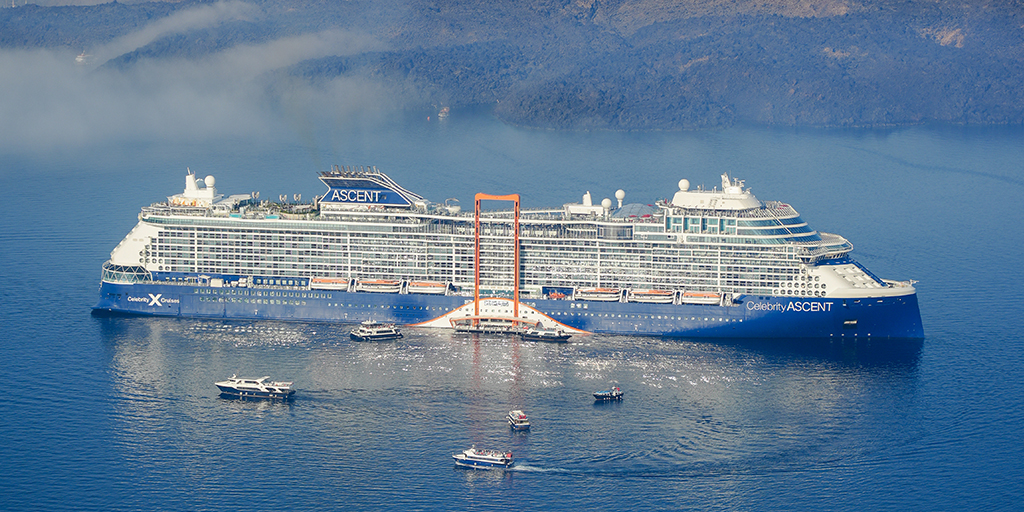- Port : Rp 8.316.000
- Taxes : Rp 5.880.000
- Accommodation Onboard
- Meals Onboard*
- Entertainment Onboard
- Facilities Onboard*
Celebrity Ascent – 11 Night Greece, Turkey & Italy Cruise
- Rome (Civitavecchia), Italy - At Sea - Chania (Souda), Crete, Greece - Santorini, Greece - Santorini, Greece - Ephesus (Kusadasi), Turkey - Istanbul, Turkey - Istanbul, Turkey - At Sea - Mykonos, Greece - At Sea - Naples, Italy - Rome (Civitavecchia), Italy
- 11
- Celebrity Ascent
- 2 - 2
-
-
Trip Summary
About Trip
This Trip Cost Includes :
This Trip Cost Excludes :
- Gratuities
- International Flight
- Travel Insurance
- Travel Documents / Visa
- Personal Expenses
Schedule Trip
Itinerary
Civitavecchia is a coastal town northwest of Rome, in Italy. Built in the 2nd century, the Port of Civitavecchia still retains some of its original features, like the Roman Dock. The port area also includes the 16th-century Michelangelo Fort. Nearby, the National Archaeological Museum displays bronze and ceramic artifacts. Northeast of town are the Terme Taurine, the ruins of a Roman thermal bath complex.
Souda is a town and former municipality in the Chania regional unit, Crete, Greece. Since the 2011 local government reform it is part of the municipality Chania, of which it is a municipal unit. The municipal unit has an area of 22.007 km². It is an important ferry and naval port at the head of Souda Bay.
Santorini is one of the Cyclades islands in the Aegean Sea. It was devastated by a volcanic eruption in the 16th century BC, forever shaping its rugged landscape. The whitewashed, cubiform houses of its 2 principal towns, Fira and Oia, cling to cliffs above an underwater caldera (crater). They overlook the sea, small islands to the west and beaches made up of black, red and white lava pebbles.
Ephesus is an ancient city in Turkey’s Central Aegean region, near modern-day Selçuk. Its excavated remains reflect centuries of history, from classical Greece to the Roman Empire – when it was the Mediterranean’s main commercial center – to the spread of Christianity. Paved streets wind past squares, baths and monumental ruins. The Temple of Hadrian was built before 138 A.D. for Emperor Hadrian’s visit.
Istanbul is a major city in Turkey that straddles Europe and Asia across the Bosphorus Strait. Its Old City reflects cultural influences of the many empires that once ruled here. In the Sultanahmet district, the open-air, Roman-era Hippodrome was for centuries the site of chariot races, and Egyptian obelisks also remain. The iconic Byzantine Hagia Sophia features a soaring 6th-century dome and rare Christian mosaics.
Istanbul is a major city in Turkey that straddles Europe and Asia across the Bosphorus Strait. Its Old City reflects cultural influences of the many empires that once ruled here. In the Sultanahmet district, the open-air, Roman-era Hippodrome was for centuries the site of chariot races, and Egyptian obelisks also remain. The iconic Byzantine Hagia Sophia features a soaring 6th-century dome and rare Christian mosaics.
Mykonos is an island in the Cyclades group in the Aegean Sea. It's popularly known for its summer party atmosphere. Beaches such as Paradise and Super Paradise have bars that blare thumping music. Massive dance clubs attract world-renowned DJs and typically stay open well past dawn. Iconic landmarks include a row of 16th-century windmills, which sit on a hill above Mykonos town.
Naples is the regional capital of Campania and the third-largest city of Italy, after Rome and Milan, with a population of 908,082 within the city's administrative limits as of 2025, while its province-level
Civitavecchia is a coastal town northwest of Rome, in Italy. Built in the 2nd century, the Port of Civitavecchia still retains some of its original features, like the Roman Dock. The port area also includes the 16th-century Michelangelo Fort. Nearby, the National Archaeological Museum displays bronze and ceramic artifacts. Northeast of town are the Terme Taurine, the ruins of a Roman thermal bath complex.


